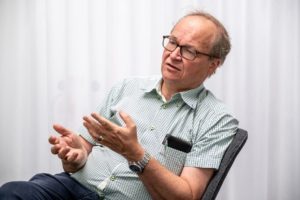
Elders in skilled nursing facilities spend most of their time indoors. However, the need for healthy light increases with age as the pupil gets smaller and the eye’s lens thickens, requiring even more light. Older people need more intensive light to aid vision and, more importantly, to stimulate their diurnal rhythm, a biological rhythm harmonized with the cycle of day and night.
The need for healthy lighting
Inadequate lighting in nursing facilities increases the risk of a fall by 1.5 times, resulting in hip fractures and head injuries. It also triggers a vicious circle of immobility and sleep problems that cause many older people to experience periods of depression, irritation and bad temper. And those with Alzheimer’s Disease and related dementias experience increased agitation and nighttime restlessness from a lack of natural light exposure, to name just a few issues.
Scientific advances have led to a new kind of therapeutic lighting that provide eldercare residents with the natural light they need to improve their alertness, mood, energy, sleep and cognitive wellbeing. This lighting works by synchronizing a resident’s circadian rhythms to the solar day while indoors and can be fine-tuned to an individual’s unique biological needs.
The benefits of this BioCentric Lighting lighting also extend to caregivers and other staff in skilled nursing facilities. In an environment of natural light, employees feel better, gain higher concentration levels and find it easier to focus on daily tasks.
Light to restore sleep
Sleep-related problems are a chronic challenge for skilled nursing facilities. Earlier bedtimes and wake-up times, along with frequent awakenings, can result in more fragmented, lower-quality sleep for older adults.
Several studies have shown how light therapy can improve nighttime sleep. A 2020 study by the Brown University School of Public Health found that using tuned LED lighting halved the number of sleep disturbances among older long-term care residents. Tuned LED lighting works by helping to regulate an individual’s circadian rhythm, which directs the melatonin sleep hormone and activates the cortisol hormone, boosting energy and alertness in the daytime.
BioCentric Lighting advances this science even further, with an ability to learn from and respond to an individual’s unique biology or a group’s (e.g., residents with dementia) environmental lighting needs. The technology utilizes sensors and algorithms to adapt to different users, activities and times of the day. This adaptability, in turn, promotes a natural circadian rhythm and improved, more efficient sleep.
Light to reduce depression, improve cognition
It’s no surprise that light can improve mood, as light therapy has been used for many years to treat seasonal affective disorder.
Light technology also offers beneficial effects in those with ADRD. As we get older, the brain ages, with a marked decrease in the total cell mass of the timekeeping center located in the suprachiasmatic nucleus in older people. This aging is even more pronounced in people with Alzheimer’s disease and dementia, resulting in increasingly abnormal sleep patterns.
While abnormal sleep affects nearly all elderly people, the resulting depression is particularly acute among people with ADRD. Light therapy can offer substantial relief.
For instance, a 12-week pilot conducted by researchers at the University of Southern California revealed that light can create a positive effect on mood and decrease depression by restoring a person’s natural circadian rhythm and sleep-wake cycle. The study divided a group of 77 long-term care residents with dementia into one group that was exposed to increased natural light each morning and another that was not. Those in the daylight intervention group experienced a decrease in depressive symptoms during the study.
Another study published in Clinical Interventions in Aging in which therapeutic light was installed in 14 nursing home resident rooms to regulate their circadian rhythms during the daytime saw a significant reduction of depressive symptoms and increased total sleep time.
Intelligent therapeutic lighting can also potentially improve cognition in elders with ADRD. Researchers found that more intense light administered in the morning hours improved residents’ Mini-Mental State Examination (MMSE) scores – an international standard used to test cognitive function among the elderly – especially with those in the early stages of the disease.
Lighting the future
The elderly population has different lighting needs compared to younger individuals. A big challenge with light in skilled nursing facilities is adapting the light solution to a workplace where multiple activities require different solutions for different rooms.
Advances in therapeutic lighting have introduced lighting systems that can easily be customized according to the unique needs of the individual workplace. The light environment provides both elderly residents and the staff that care for them with the light they need each day, regardless of the season. Emerging research provides new understandings of the beneficial effects of light for improving sleep and wellbeing. Smart therapeutic lighting can be tailored to meet these new insights now and in the future.
Tord Wingren is the founder of BrainLit and is the innovator and patent initiator of BrainLit’s basic patents. He has more than 30 years of experience within the IT and communication industries and pioneered Bluetooth by writing its first specification.




